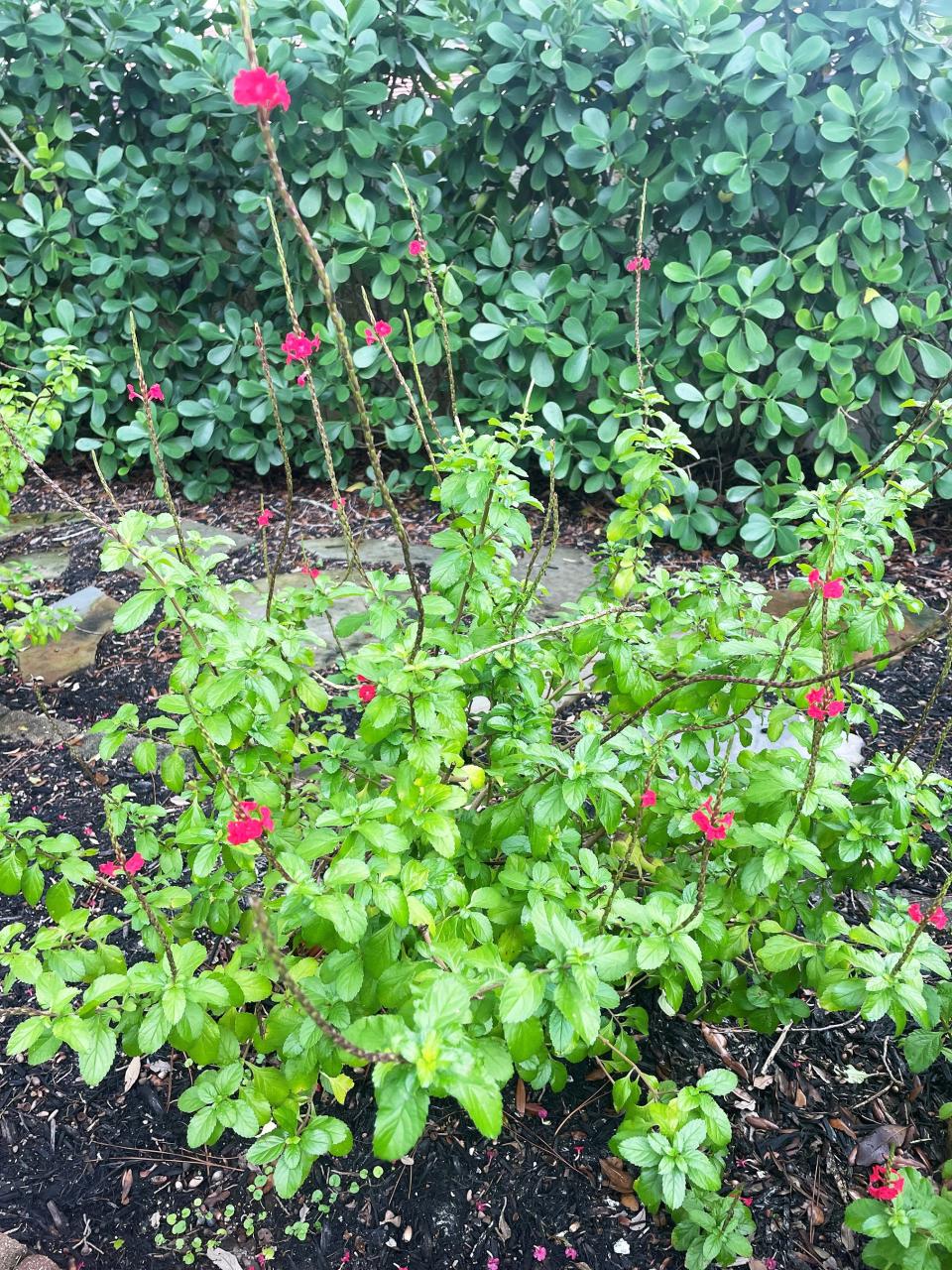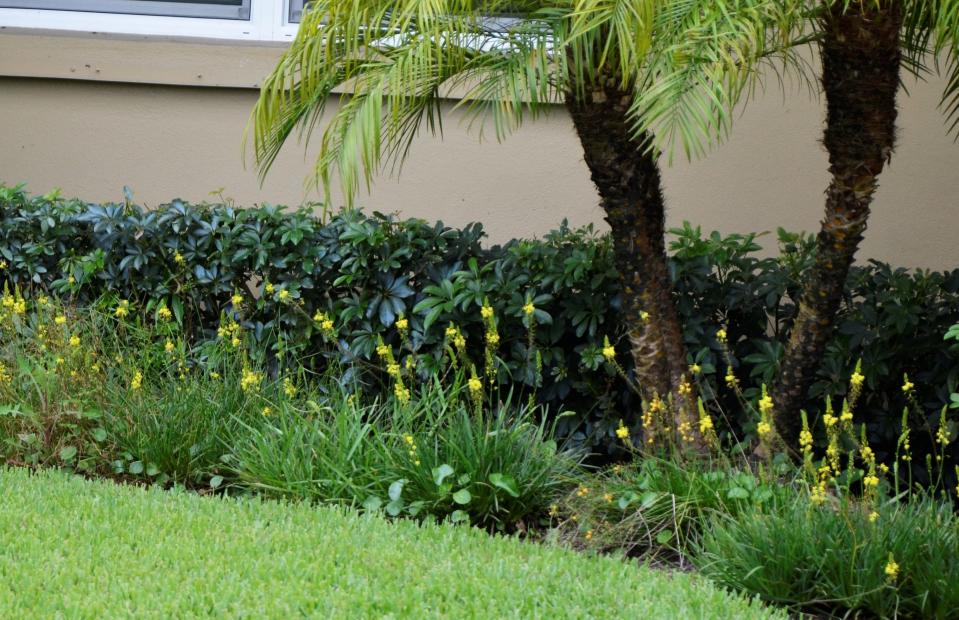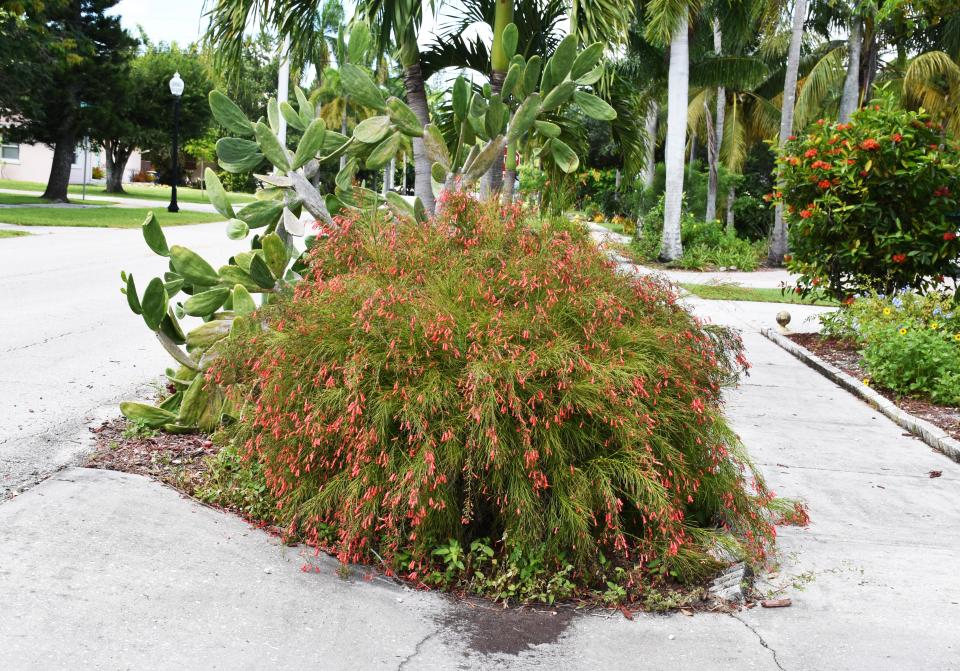Master Gardener: Plants that bloom year-round
Each day I check the weather forecast to see if there is a chance for sunshine. This January has been exceptionally cloudy, which can translate to gloomy for those of us who are used to sunny skies. It lifts my spirits to look out at my garden and see the colorful blooms. Vibrant colors of red and pink provide a bright contrast to the gray skies. We are fortunate to live in Southwest Florida where a diversity of plants blooms year-round. I have compiled a list of some of the plants which bloom all year, most of which grow better in full sun. Although some can be planted in partial shade, they may not bloom continually.
Firespike (Odontonema cuspidatum) is a small shrub that produces clusters of 3-inch-long tubular red flowers. It attracts hummingbirds and several species of butterflies. It grows four to six feet tall and can be massed at the back of a garden bed or can work well in cutting gardens.

Autumn sage (Salvia greggii) is a soft mounding shrub normally two to three feet tall which blooms repeatedly. Its flowers are borne on long stems and can be red, pink, purple, orange, or white, with red being the most common.
Mexican heather (Cuphea hyssopifolia) is a small evergreen shrub. It grows up to two feet tall, with small purple, lavender, or white flowers blooming among the green foliage. Mexican heather can be grown in garden beds and can be used in containers or as ground cover. Cut it back in the spring if plants become too leggy. This will stimulate new growth.
Plumbago is a low maintenance shrub with clusters of blue or white flowers. The two species most frequently found in Florida are Plumbago articulata, the traditional blue plumbago, and Plumbago zeylanica, the Florida-native white plumbago.
Plumbago’s phlox-like flowers give off a pleasant fragrance and attract butterflies. It is excellent as a foundation plant or will cascade down a retaining wall with a mass of showy flowers. The plumbago is toxic, so wear gardening gloves and long sleeves and pants while working with the plant. Keep pets and children away from it, as it is harmful if ingested.
Blue Daze (Evolvulus nuttallianus) has blue funnel-shaped petals with silvery-green foliage. It is a short-lived perennial persisting for usually no more than two years. The leaves feel velvety when touched and the blue flowers are the size of a dime. It is often hung over the edge of baskets or containers and can spread over flower beds as a ground cover. Blue Daze can also tolerate salty conditions, which makes it a good option for coastal gardens.

Bulbine (Bulbine frutescens) is an herbaceous succulent perennial with onion-like leaves about six to nine inches tall. It spreads to about two feet and each plant will clump and create more plants. Bulbine comes in yellow or orange flowering cultivars, with flowers spiking up to two feet tall. Remove spent flower stems to encourage continuous bloom. It contains glycoproteins, like many aloe species, and is said to have similar healing properties to ease burns and rashes.
Ixora (Ixora spp.) is a perennial shrub which bears clusters of four-petaled flowers. Each cluster can last six to eight weeks and comes in a variety of colors including bright red, orange, yellow, pink, and white. For those who struggle to pronounce this Latin name, just remember that Ixora is pronounced “icks-SORE-ah”. Some types of Ixora can grow ten to fifteen feet tall and four to ten feet wide, but pruning can help to maintain them as a smaller hedge. Be careful, though, as too much trimming will reduce Ixora’s flower production.

The firecracker plant (Russelia equisetiformis) can have a dramatic effect in your garden with its profusion of red tubular flowers and arching stems. Yellow and salmon types are also available. This plant can reach three to four feet tall and six or more feet wide, so make sure that it has room to sprawl. Pruning the Firecracker encourages flowering and can be done any time of the year. You may prefer to just trim off dead portions of the plant and deadhead spent flowers, so that it will retain its ornamental look.
In much of the country Gerbera daisies (Gerbera jamesonii) are grown as seasonal annuals. In Florida, however, gardeners are fortunate to enjoy these flowers nearly year-round. The blooms are long lasting and come in bright shades of red, pink, white, lavender, and orange. The flower sits on a leafless stem about six inches above the plant’s striking foliage of long, slightly fuzzy leaves. For best results, plant your Gerbera daisies in sandy soil which has been amended with organic matter. Good drainage is important, since excessive moisture can lead to root and crown disease. If your soil does not have good drainage, Gerberas can be grown in containers, raised beds, or mounds.
A popular year-round bloomer is the Bougainvillea (Bougainvillea spectabilis), also called the paper flower. This plant grows quickly and comes in a variety of bright colors. The Bougainvillea needs regular pruning to maintain its shape and to encourage flowering. Because of its thorns, be sure to wear long gardening gloves and a long-sleeved shirt when pruning or working around this plant. The taller types of Bougainvillea need support and can be trained on a trellis, over an arbor, or on a fence.
To help plants bloom all year, it is essential to follow the principle: Right Plant, Right Place. Also, remember to deadhead flowers and to use mulch to retain moisture, regulate the temperature of the soil, provide nutrients, and prevent weeds. It is important to stay updated on the latest horticultural research and gardening techniques.
The Lee County Master Gardener Volunteers have many educational opportunities available during the winter months. These programs include Florida Native Landscaping, All About Rain Barrels, Low Maintenance Plants for Your Yard, and the family oriented STEMtastic Day of Discovery. For more information and to register for these classes go to https://www.eventbrite.com/o/lee-county-extension-4394003213.
More Our migratory birds are vanishing
And Southern Fresh Farms will soon hit the market in south Fort Myers
Also Gators, manatees and Thomas Edison: 5 bucket list things to do in Lee County
Carole Kerns is a Master Gardener Volunteer with UF/IFAS Lee County Extension. You can contact Carole and other Master Gardeners with your gardening questions at extgardener@leegov.com or call (239)533-7504 between 10:00 am and 2:00 pm. Follow the extension service on Instagram at lee_ufifas. The University of Florida is an Equal Opportunity Institution.
This article originally appeared on Fort Myers News-Press: Master Gardener: Plants that bloom year-round

